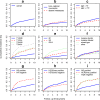Risk of loco-regional recurrence and distant metastases of patients with invasive breast cancer up to ten years after diagnosis - results from a registry-based study from Germany
- PMID: 31146706
- PMCID: PMC6543576
- DOI: 10.1186/s12885-019-5710-5
Risk of loco-regional recurrence and distant metastases of patients with invasive breast cancer up to ten years after diagnosis - results from a registry-based study from Germany
Abstract
Background: Population-based estimates of the long-term risk of loco-regional recurrence and distant metastases of breast cancer (BRC) patients are scant, as most published studies used hospital-based cohorts or participants of clinical trials. This work aims to extend available knowledge by providing population-based long-term estimates of the cumulative risk of BRC recurrence up to 10 years after diagnosis.
Methods: Data from the population-based Saarland Cancer Registry were used and included 9359 female patients with primary invasive BRC diagnosed between 1999 and 2009. Estimates of the cumulative incidence (CI) of BRC recurrence were derived for patients who had received local surgery with free resection margins by type of recurrence and stratified by age, tumor characteristics and major treatment options, taking into account mortality from any cause as a competing risk.
Results: The 10-year CI of BRC recurrence was 16%. For loco-regional recurrence and distant metastases alone it was 8 and 11%, respectively. The estimates showed substantial variation and were particularly increased if tumors were advanced (T1/2N+ 23%, T3/4N0 24%, T3/4N+ 34%), of high grade (23%), or of 'HER2/neu positive' (28%) or 'triple negative' subtype (23%), respectively.
Conclusions: The derived estimates reflect the risk of 'real world' patients and may therefore extend available knowledge. These data are thus of great relevance for clinicians, their patients and researchers. The study likewise demonstrated the usefulness of cancer registries for a population-based monitoring of the effectiveness of cancer care in terms of disease recurrence as a major treatment related outcome measure.
Keywords: Cancer registry; Cumulative incidence; Distant metastases; Germany; Invasive breast cancer; Loco-regional recurrence; Population-based.
Conflict of interest statement
The authors declare that they have no competing interests.
Figures

References
-
- Cancer Today http://gco.iarc.fr/today. Accessed 23, Jan 2018.
-
- Sant M, Chirlaque Lopez MD, Agresti R, Sanchez Perez MJ, Holleczek B, Bielska-Lasota M, Dimitrova N, Innos K, Katalinic A, Langseth H, et al. Survival of women with cancers of breast and genital organs in Europe 1999-2007: results of the EUROCARE-5 study. Eur J Cancer. 2015;51:2191–2205. doi: 10.1016/j.ejca.2015.07.022. - DOI - PubMed
-
- Allemani C, Weir HK, Carreira H, Harewood R, Spika D, Wang XS, Bannon F, Ahn JV, Johnson CJ, Bonaventure A, et al. Global surveillance of cancer survival 1995-2009: analysis of individual data for 25,676,887 patients from 279 population-based registries in 67 countries (CONCORD-2) Lancet. 2015;385:977–1010. doi: 10.1016/S0140-6736(14)62038-9. - DOI - PMC - PubMed
-
- Wallgren A, Bonetti M, Gelber RD, Goldhirsch A, Castiglione-Gertsch M, Holmberg SB, Lindtner J, Thurlimann B, Fey M, Werner ID, et al. Risk factors for locoregional recurrence among breast cancer patients: results from international breast Cancer study group trials I through VII. J Clin Oncol. 2003;21:1205–1213. doi: 10.1200/JCO.2003.03.130. - DOI - PubMed
MeSH terms
LinkOut - more resources
Full Text Sources
Medical
Research Materials
Miscellaneous

